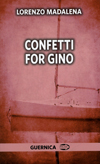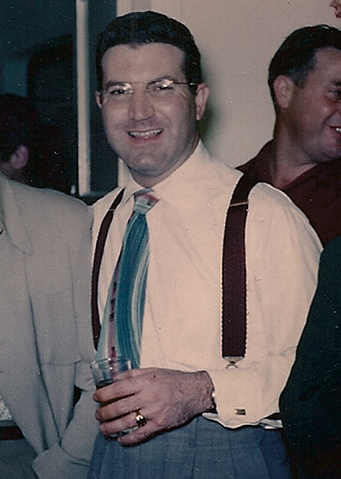by Pasquale Verdicchio
 Lorenzo Madalena’s Confetti for Gino was a Doubleday Book of the Month Club publication in 1959. The only other edition after that was a paperback Gorgi Edition published in England. That is what I found and first read of this book, on the island of Formentera, Spain, in 1979. Confetti is a fictionalized version of the everyday life in San Diego’s Little Italy of the 40s and 50s. The events and relationships described within it are true to those that took place there, and they reflect the relationship of what was then called “the Italian colony” to “American” society. When I arrived in San Diego in 1986 to teach at UCSD, and started to look into the history of the Italian American community, I realized that the novel I had read a few years before represented an important document. My search took me to the SD Library and eventually I found a couple of copies of the novel through booksellers. Convinced of the value of such a book, I brought it to the attention of my publisher, Guernica Editions. It’s taken a long time to come out, but finally, through the sponsorship of the San Diego Italian Film Festival, Confetti for Gino has been issued in a new paperback edition.
Lorenzo Madalena’s Confetti for Gino was a Doubleday Book of the Month Club publication in 1959. The only other edition after that was a paperback Gorgi Edition published in England. That is what I found and first read of this book, on the island of Formentera, Spain, in 1979. Confetti is a fictionalized version of the everyday life in San Diego’s Little Italy of the 40s and 50s. The events and relationships described within it are true to those that took place there, and they reflect the relationship of what was then called “the Italian colony” to “American” society. When I arrived in San Diego in 1986 to teach at UCSD, and started to look into the history of the Italian American community, I realized that the novel I had read a few years before represented an important document. My search took me to the SD Library and eventually I found a couple of copies of the novel through booksellers. Convinced of the value of such a book, I brought it to the attention of my publisher, Guernica Editions. It’s taken a long time to come out, but finally, through the sponsorship of the San Diego Italian Film Festival, Confetti for Gino has been issued in a new paperback edition.
Confetti should be of interest to everyone because it is a very real document of one of San Diego’s premier communities--one that figured so prominently in one of the city’s main industries: fishing. The story told is that of Gino De Marino's identity struggle. A rough and tough tuna fisherman, Gino is an ex-serviceman who returns to San Diego from the Pacific Theatre at the end of WWII, takes over his father’s fishing boat, and tries to make a living. As a serviceman he clearly fits into a San Diego landscape that is still familiar to us today: a mix of civilian and military industries and traditions that comingle and live side-by-side, even as they sometimes seem light years apart. Gino represents that sense of double-identity, as a serviceman returned to civilian life and as the son of Italian immigrants attempting to integrate more fully into “American” society. Part of his struggle is represented in the novel through Gino’s attraction to a woman who is antithetical to his community’s standards. (Most of all, she is not Italian.) What makes Gino a character that anyone can easily identify with is that his struggles are the real, everyday struggles experienced by anyone trying to make something of their lives, no matter what their background.
The pull of two different traditions, cultures, and societies is a fundamental point of focus of the book; enmeshed in this are all the relationships that move through and between those worlds and their pull on Gino. His allegiance to his family, his brother, those he cares for, and his allegiance to his own needs and desires, constitue the central challenge of the novel and illustrate one man's attempt to live in his society while remaining true to himself and his family's history. Confetti for Gino gives us an opportunity to look back and to get a taste, not only of a time gone by, but of a dimension of one of San Diego’s neighborhoods that might not be as evident today. San Diego’s Little Italy has opted for a different type of development today, one a little more distant from its own culture. Confetti for Gino represents a tessera of a mosaic that requires resetting, an ingredient of a communal recipe that can bring back some of its original flavor.
Confetti for Gino is a valuable rediscovery. While, as Ken Scambray has noted, “Madalena’s detailed descriptions of the food and folkways of the Sicilian community are intended to be his resistance to the overriding themes of assimilation and conformity of the 1950s. [And that he was] acutely aware that social policy makers at the time refused to acknowledge the reality of Americans’ diverse ethnic identity.” It is also true that in today’s globalized existence a book such as this refocuses our attention on manifestations of local culture and knowledge, and in the inherent differences that are the rule rather than the exception. I would say that rather than describe the struggles against or for assimilation, Madalena attempts to describe a struggle toward integration. This is possibly what Madalena shared with his character Gino. While Madalena fished only sporadically, he knew the culture well from his father’s activities within it, and from the many friends in the community who also worked as fishermen. Fishing represented the life-blood of Little Italy at the time, but Madalena also lived a struggle for integration in his personal life. He was not alone in choosing a life outside of fishing, but that didn’t make it any easier. He held advanced degrees that reflected his interests in writing and teaching, a fact that possibly distanced him from his community and flung him closer to the outside world. Both Lorenzo and Gino were of immigrant families, both lived in San Diego’s Little Italy, both fished, and both struggled with their identity and their desire to integrate more fully into American society without giving up too much of their Italian identity.
Confetti for Gino by Lorenzo Madalena (Guernica Editions, 2011); Postface by Pasquale Verdicchio, is available through Amazon, or through Small Press Distribution, Berkeley (http://www.spdbooks.org/Producte/9781550712247/confetti-for-gino.aspx), as well as San Diego Italian Film Festival events as long as copies last.

